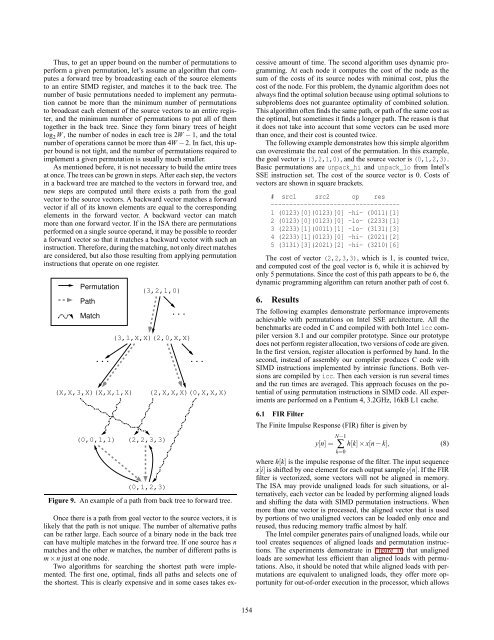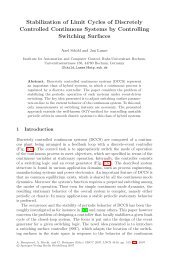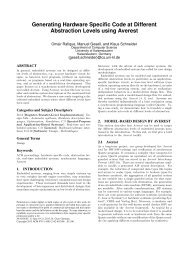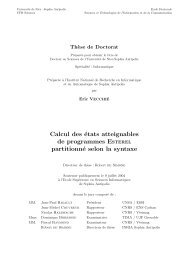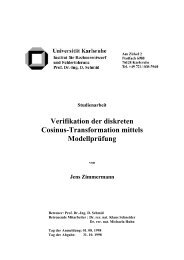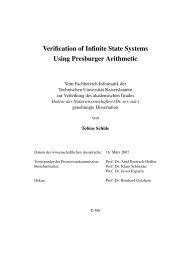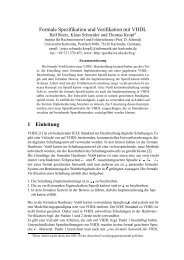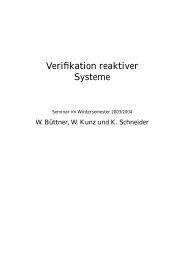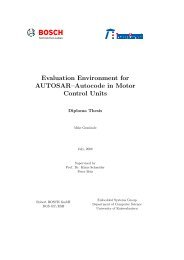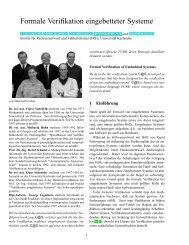Generation of permutations for {SIMD} processors - Embedded ...
Generation of permutations for {SIMD} processors - Embedded ...
Generation of permutations for {SIMD} processors - Embedded ...
You also want an ePaper? Increase the reach of your titles
YUMPU automatically turns print PDFs into web optimized ePapers that Google loves.
Thus, to get an upper bound on the number <strong>of</strong> <strong>permutations</strong> to<br />
per<strong>for</strong>m a given permutation, let’s assume an algorithm that computes<br />
a <strong>for</strong>ward tree by broadcasting each <strong>of</strong> the source elements<br />
to an entire <strong>SIMD</strong> register, and matches it to the back tree. The<br />
number <strong>of</strong> basic <strong>permutations</strong> needed to implement any permutation<br />
cannot be more than the minimum number <strong>of</strong> <strong>permutations</strong><br />
to broadcast each element <strong>of</strong> the source vectors to an entire register,<br />
and the minimum number <strong>of</strong> <strong>permutations</strong> to put all <strong>of</strong> them<br />
together in the back tree. Since they <strong>for</strong>m binary trees <strong>of</strong> height<br />
log 2 W, the number <strong>of</strong> nodes in each tree is 2W − 1, and the total<br />
number <strong>of</strong> operations cannot be more than 4W − 2. In fact, this upper<br />
bound is not tight, and the number <strong>of</strong> <strong>permutations</strong> required to<br />
implement a given permutation is usually much smaller.<br />
As mentioned be<strong>for</strong>e, it is not necessary to build the entire trees<br />
at once. The trees can be grown in steps. After each step, the vectors<br />
in a backward tree are matched to the vectors in <strong>for</strong>ward tree, and<br />
new steps are computed until there exists a path from the goal<br />
vector to the source vectors. A backward vector matches a <strong>for</strong>ward<br />
vector if all <strong>of</strong> its known elements are equal to the corresponding<br />
elements in the <strong>for</strong>ward vector. A backward vector can match<br />
more than one <strong>for</strong>ward vector. If in the ISA there are <strong>permutations</strong><br />
per<strong>for</strong>med on a single source operand, it may be possible to reorder<br />
a <strong>for</strong>ward vector so that it matches a backward vector with such an<br />
instruction. There<strong>for</strong>e, during the matching, not only direct matches<br />
are considered, but also those resulting from applying permutation<br />
instructions that operate on one register.<br />
Permutation<br />
Path<br />
Match<br />
...<br />
(X,X,3,X)(X,X,1,X)<br />
(3,2,1,0)<br />
(3,1,X,X)(2,0,X,X)<br />
(0,0,1,1) (2,2,3,3)<br />
(0,1,2,3)<br />
...<br />
...<br />
(2,X,X,X)(0,X,X,X)<br />
Figure 9. An example <strong>of</strong> a path from back tree to <strong>for</strong>ward tree.<br />
Once there is a path from goal vector to the source vectors, it is<br />
likely that the path is not unique. The number <strong>of</strong> alternative paths<br />
can be rather large. Each source <strong>of</strong> a binary node in the back tree<br />
can have multiple matches in the <strong>for</strong>ward tree. If one source has n<br />
matches and the other m matches, the number <strong>of</strong> different paths is<br />
m × n just at one node.<br />
Two algorithms <strong>for</strong> searching the shortest path were implemented.<br />
The first one, optimal, finds all paths and selects one <strong>of</strong><br />
the shortest. This is clearly expensive and in some cases takes excessive<br />
amount <strong>of</strong> time. The second algorithm uses dynamic programming.<br />
At each node it computes the cost <strong>of</strong> the node as the<br />
sum <strong>of</strong> the costs <strong>of</strong> its source nodes with minimal cost, plus the<br />
cost <strong>of</strong> the node. For this problem, the dynamic algorithm does not<br />
always find the optimal solution because using optimal solutions to<br />
subproblems does not guarantee optimality <strong>of</strong> combined solution.<br />
This algorithm <strong>of</strong>ten finds the same path, or path <strong>of</strong> the same cost as<br />
the optimal, but sometimes it finds a longer path. The reason is that<br />
it does not take into account that some vectors can be used more<br />
than once, and their cost is counted twice.<br />
The following example demonstrates how this simple algorithm<br />
can overestimate the real cost <strong>of</strong> the permutation. In this example,<br />
the goal vector is (3,2,1,0), and the source vector is (0,1,2,3).<br />
Basic <strong>permutations</strong> are unpack_hi and unpack_lo from Intel’s<br />
SSE instruction set. The cost <strong>of</strong> the source vector is 0. Costs <strong>of</strong><br />
vectors are shown in square brackets.<br />
# src1 src2 op res<br />
-----------------------------------<br />
1 (0123)[0](0123)[0] -hi- (0011)[1]<br />
2 (0123)[0](0123)[0] -lo- (2233)[1]<br />
3 (2233)[1](0011)[1] -lo- (3131)[3]<br />
4 (2233)[1](0123)[0] -hi- (2021)[2]<br />
5 (3131)[3](2021)[2] -hi- (3210)[6]<br />
The cost <strong>of</strong> vector (2,2,3,3), which is 1, is counted twice,<br />
and computed cost <strong>of</strong> the goal vector is 6, while it is achieved by<br />
only 5 <strong>permutations</strong>. Since the cost <strong>of</strong> this path appears to be 6, the<br />
dynamic programming algorithm can return another path <strong>of</strong> cost 6.<br />
6. Results<br />
The following examples demonstrate per<strong>for</strong>mance improvements<br />
achievable with <strong>permutations</strong> on Intel SSE architecture. All the<br />
benchmarks are coded in C and compiled with both Intel icc compiler<br />
version 8.1 and our compiler prototype. Since our prototype<br />
does not per<strong>for</strong>m register allocation, two versions <strong>of</strong> code are given.<br />
In the first version, register allocation is per<strong>for</strong>med by hand. In the<br />
second, instead <strong>of</strong> assembly our compiler produces C code with<br />
<strong>SIMD</strong> instructions implemented by intrinsic functions. Both versions<br />
are compiled by icc. Then each version is run several times<br />
and the run times are averaged. This approach focuses on the potential<br />
<strong>of</strong> using permutation instructions in <strong>SIMD</strong> code. All experiments<br />
are per<strong>for</strong>med on a Pentium 4, 3.2GHz, 16kB L1 cache.<br />
6.1 FIR Filter<br />
The Finite Impulse Response (FIR) filter is given by<br />
N−1<br />
y[n] = ∑ h[k] × x[n − k], (8)<br />
k=0<br />
where h[k] is the impulse response <strong>of</strong> the filter. The input sequence<br />
x[i] is shifted by one element <strong>for</strong> each output sample y[n]. If the FIR<br />
filter is vectorized, some vectors will not be aligned in memory.<br />
The ISA may provide unaligned loads <strong>for</strong> such situations, or alternatively,<br />
each vector can be loaded by per<strong>for</strong>ming aligned loads<br />
and shifting the data with <strong>SIMD</strong> permutation instructions. When<br />
more than one vector is processed, the aligned vector that is used<br />
by portions <strong>of</strong> two unaligned vectors can be loaded only once and<br />
reused, thus reducing memory traffic almost by half.<br />
The Intel compiler generates pairs <strong>of</strong> unaligned loads, while our<br />
tool creates sequences <strong>of</strong> aligned loads and permutation instructions.<br />
The experiments demonstrate in Figure 10 that unaligned<br />
loads are somewhat less efficient than aligned loads with <strong>permutations</strong>.<br />
Also, it should be noted that while aligned loads with <strong>permutations</strong><br />
are equivalent to unaligned loads, they <strong>of</strong>fer more opportunity<br />
<strong>for</strong> out-<strong>of</strong>-order execution in the processor, which allows<br />
LCTES’05, 8 2005/4/16<br />
154


